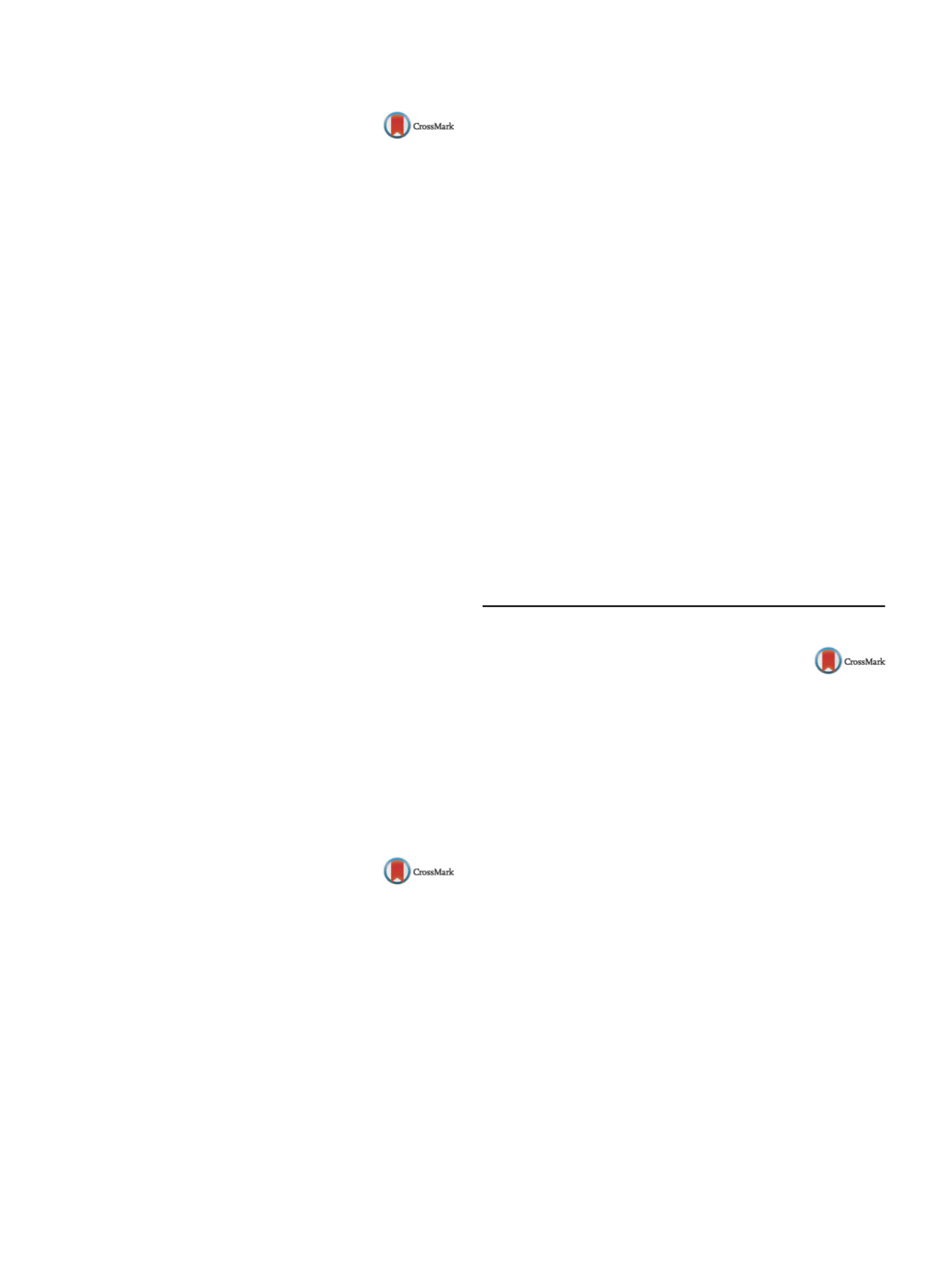

S266
25th European Congress of Psychiatry / European Psychiatry 41S (2017) S238–S302
EW0469
Relationship between self-reported
and clinician-rated psychopathology
in youth psychiatric outpatients
J. Silva Ribeiro
∗
, S. Morais , P. Oliveira , E. Mendes , A. Botelho ,
H. Godinho , L. Vale , A. Bessa , P. Renca , V. Santos , N. Madeira
Psychiatry Department, Coimbra Hospital and University Centre,
Coimbra, Portugal
∗
Corresponding author.
Introduction
Psychopathology rating scales have been widely
used. Studies evaluating the congruence between self and observer-
reported ratings show inconsistent results.
Objectives or aims
Determine whether there was consistency
between psychopathology as assessed by patients and clinicians’
assessment in outpatients observed in the Young Adult Unit of our
Psychiatry Department (Coimbra Hospital and University Centre-
Portugal).
Methods
Socio-demographic characterization was undertaken
with young adult outpatients observed during nineteen months
(1st January 2015–31st July 2016). Brief Symptom Inventory–53
items (BSI-53) and Brief Psychiatric Rating Scale (BPRS) were
applied at the first clinical evaluation. Spearman correlation coeffi-
cient between General Severity Index (GSI) of BSI-53 and BPRS total
score was calculated.
Results
During the mentioned interval 255 outpatients were
observed: 64.3% females and 35.7% males; aged between 17 and
39 years old (average: 20.56; median: 20). Fifty percent were
diagnosed with neurotic, stress-related and somatoform disor-
ders (ICD-10 F40-48) and 14.1% with mood disorders (ICD-10
F30-39). BPRS and BSI-53 rating scales were administered to 55
patients: 72.5% females and 27.5% males; average age 21.2. A sta-
tistical significant correlation was found between BPRS total and
GSI score.
Conclusions
Several factors can determine the accuracy of psy-
chopathology self-assessment, including diagnosis and severity of
illness. In fact, studies show strong correlation between self and
observer assessment of depressive and anxious psychopathology,
but no correlation in psychotic psychopathological dimensions.
Therefore, the correlation found in this population can be explained
by the fact that the majority of patients were diagnosed with neu-
rotic, stress-related and somatoform and mood disorders.
Disclosure of interest
The authors have not supplied their decla-
ration of competing interest.
http://dx.doi.org/10.1016/j.eurpsy.2017.02.083EW0470
Executive functions in delusion-prone
individuals – Preliminary studies
A. Tereszko
1 ,∗
, W. Janeczko
1, J. Słowik
1, K. Brzezicka
1,
K. Prochwicz
2, M. Siwek
3, D. Dudek
31
Students Scientific Association of Affective Disorders, Jagiellonian
University Medical College, Kraków, Poland
2
Institute of Psychology, Jagiellonian University, Kraków, Poland
3
Department of Affective Disorders, Jagiellonian University Medical
College, Kraków, Poland
∗
Corresponding author.
Introduction
Executive dysfunctions in psychotic disorders,
mainly schizophrenia are well-known phenomenon, however the
information about executive functioning in subclinical psychotic
states are still scarce. The rationale for focusing on the delusion-
proneness (delusion-like states) is suggested role of executive
dysfunction in the process of developing delusions.
Aims
Our aim is to assess the relationship between delusion-
proneness and executive functions.
Objectives
We would like to assess two cognitive func-
tions: shifting and inhibition and updating, depending on the
severity of delusion-like symptoms. We expect that higher
delusion-proneness is associated with more pronounced executive
dysfunctions, as it is observed in clinical population with existing
delusions.
Methods
In order to assess delusion-proneness, we used Polish
version of Peters et al. Delusions Inventory (PDI). To evaluate shift-
ing and inhibition, two test were conducted–Berg’s Card Sorting
Task (BCST) and Stroop task respectively. Correlation analysis were
performed.
Results
Sixty-four participants (41 women and 23 men) were
recruited in this study. Mean age was 28.8, SD = 10.37. Statistical
analysis revealed significant negative correlation of PDI distress
subscale and BCST non-perseverative errors. The overall score, as
well as all PDI subscales correlated negatively also with the Stroop
task’s total number of errors and positively with the accuracy in
incongruent variant.
Conclusions
Contrary to our expectation, results have shown that
delusion-proneness is associated with better results in executive
functions test, especially in terms of accuracy. These results suggest
that executive functions may play a role in the development and
maintenance of delusional ideation, however, its relationship may
be a bit more complex.
Disclosure of interest
The authors have not supplied their decla-
ration of competing interest.
http://dx.doi.org/10.1016/j.eurpsy.2017.02.084e-Poster Walk: Schizophrenia and other psychotic
disorders - Part 3
EW0471
Impact of an intervention of
neuro-cognitive rehabilitation in
treatment resistant schizophrenia
(TRS) compared to schizophrenia
responder patients
L. D’Ambrosio , E. Prinzivalli , N. Oliviero , R. Balletta , G. Callovini ,
A. Benedetta , M.V. Formato , S. Lattanzio , E. Razzino ,
C. Avagliano , F. Iasevoli
∗
, A. de Bartolomeis
Department of Neuroscience Reproductive Sciences and
Odontostomatology, University of Naples Federico II, Naples, Italy
∗
Corresponding author.
Introduction
Schizophrenia is a condition with high impact in
terms of disability, also because between 30% and 60% affected indi-
viduals do not respond to treatment. It has been proposed that
cognitive functioning is strongly impaired in schizophrenia and
even more in TRS patients. Cognitive dysfunctions are regarded
to worsen psychopathology, psychosocial functioning, and overall
course of the illness.
Objectives
To investigate the impact of Cognitive Remediation
(CR) on psychopathology and psychosocial functioning in TRS vs.
schizophrenia responder patients.
Aims
To determine whether a CR intervention could improve
functional outcomes in TRS patients.
Methods
We evaluated proximal and distal effects of CR on
approximately 20 schizophrenia responders and 20 TRS patients.
Patients in each group were randomized to receive CR or not.
Patients were assessed in training task performance, neurocogni-
tion, functional capacity, symptoms and psychosocial functioning.
Evaluations were conducted at baseline, at the end of the 4-month
intervention, and at 6-month, 1 and 2 year-follow-ups. The study
is still in active recruitment phase.
Results
Both TRS and schizophrenia responder patients exposed
to CR exhibited a significant improvement in specific neurocog-


















